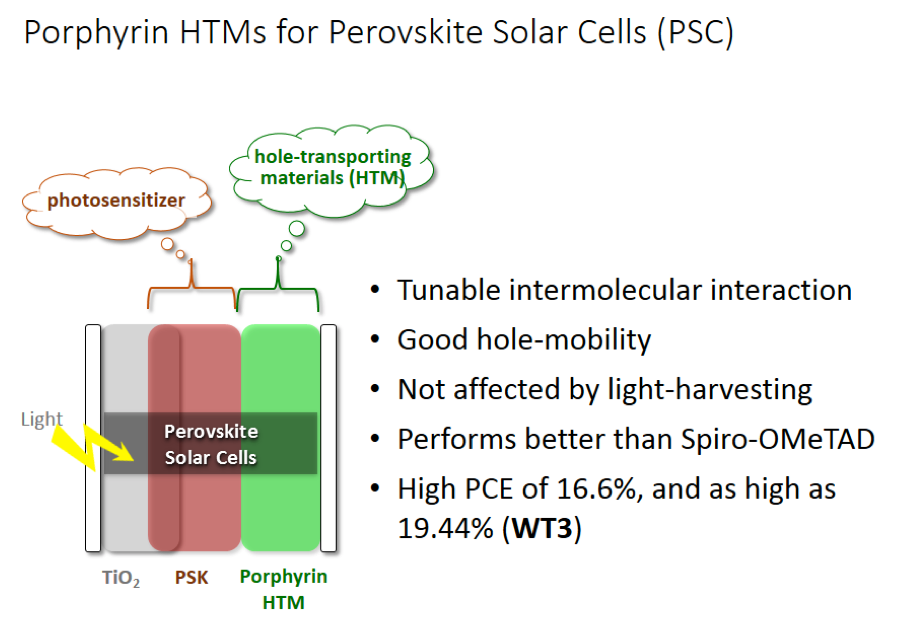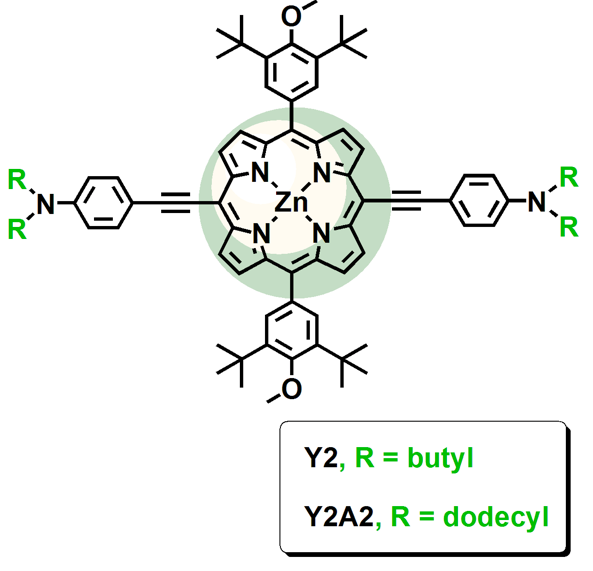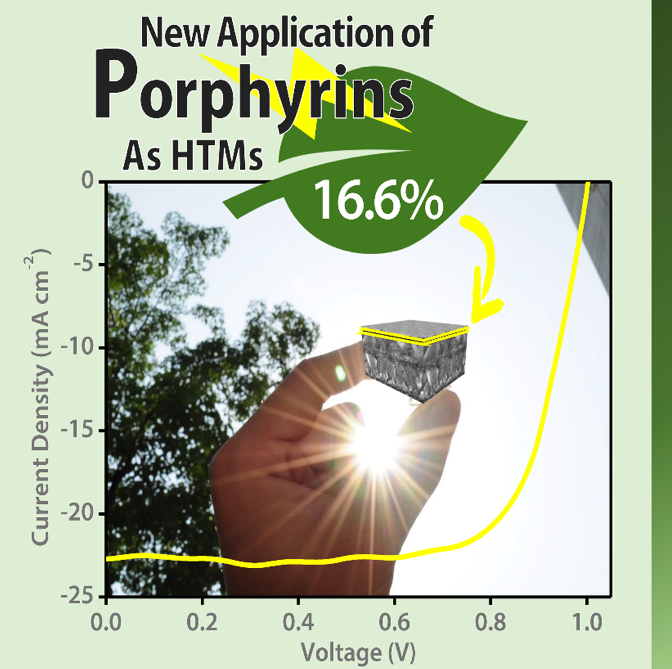光電轉換效率高達16.6%的鈣鈦礦太陽能電池之關鍵:以鋅紫質-乙炔基苯胺共軛物作為新型電洞傳輸材料





Zinc Porphyrin‒Ethynylaniline Conjugates as Novel Hole-Transporting Materials for Perovskite Solar Cells with Power Conversion Efficiency of 16.6%
光電轉換效率高達16.6%的鈣鈦礦太陽能電池之關鍵:以鋅紫質-乙炔基苯胺共軛物作為新型電洞傳輸材料
ACS Energy Lett., 2016, 1, 956-962
DOI: 10.1021/acsenergylett.6b00432
Hsien-Hsin Chou, Yu-Hsien Chiang, Ming-Hsien Li, Po-Shen Shen, Hsiang-Jung Wei, Chi-Lun Mai, Peter Chen,* Chen-Yu Yeh,*
New zinc porphyrins Y2 and Y2A2 have been utilized in perovskite solar cells specifically as hole-transporting materials (HTMs) rather than photosensitizers. These materials are structurally simple and easy to synthesize. The combination of MAPbI3 as photosensitizer and porphyrins as HTMs is a potential alternative to well-known MAPbI3/Spiro-OMeTAD hybrids owing to high performance and versatility toward molecular engineering of porphyrin families. The films of porphyrin HTMs presented in this work exhibit good hole-transporting ability, especially in the case of Y2. The high efficiency of 16.60% achieved by n-butyl tethered Y2 HTM is comparable to that of Spiro-OMeTAD of 18.03%. Both materials possess similar HOMO level and the same order of magnitude of hole mobility at 10−4 cm2 V−1 s−1. The low HOMO level, high hole mobility, and fewer observed surface pinholes while deposited on perovskite lead to open-circuit voltage and shortcircuit current of Y2 comparable to those of Spiro-OMeTAD. The slightly poorer performance of 10.55% is obtained for n-dodecyl tethered Y2A2 HTM. This is believed to stem from more surface pinholes when deposited on perovskite leading to an order of magnitude slower mobility. Unlike spiro and most organic frameworks, the total of 13 positions on the peripheral (4 meso and 8 beta positions) and coordination center of a porphyrin indicates high versatility of structural modification such that future fine-tuning of photophysical, electrochemical, and charge-transporting properties become feasible. Considering the absence of porphyrin-based HTMs for use in PSCs, this work opens a new paradigm of hole-transporters based on porphyrin families.
最近,本實驗室新設計並合成出以鋅紫質為基礎的新型電洞傳輸材料(HTM),分別為Y2和Y2A2,並用於鈣鈦礦太陽能電池。這些材料結構相當簡單且易於合成。由於作為光敏劑的鈣鈦礦(MAPbI3)和作為HTM的Spiro-OMeTAD之雜化物組合有許多缺點,我們因此利用分子工程技術開發出高性能與多功能性之MAPbI3/紫質雜化物材料來替代。本研究中提出的紫質HTM,特別是Y2之薄膜,表現出相當不錯的電洞傳輸能力。具正丁基胺取代之Y2 HTM(光電轉換效率16.60%)與Spiro-OMeTAD(光電轉換效率18.03%)之效率表現相當接近。此兩種材料都具有相似的HOMO能階,並同樣具有在10-4 cm2 V-1 s-1範圍之電洞遷移率。當分佈於鈣鈦礦上時,Y2所具有的低HOMO能階、高電洞遷移率和較少的表面針孔缺陷,使其開路電壓和短路電流可與Spiro-OMeTAD相互匹敵。而效率表現稍差、具正十二烷基胺取代之Y2A2 HTM(光電轉換效率10.52%),被認為是受因於較多的表面針孔缺陷導致電荷傳輸能力降低一個數量級所導致。本研究之重點—紫質,其與spiro結構之化合物或大多數有機物不同,由於其外圍(4個meso位置和8個beta位置)和配位中心上的總共13個位置可藉由結構修飾而達到高度多功能性,進而使得紫質材料於光物理、電化學和電荷傳輸等性質之微調變得可行。此外,由於過往並無研究觸及基於紫質之鈣鈦礦太陽能電池材料,因此,本工作無疑地開闢了高效率紫質電洞傳輸材料的新典範。
Attachment



